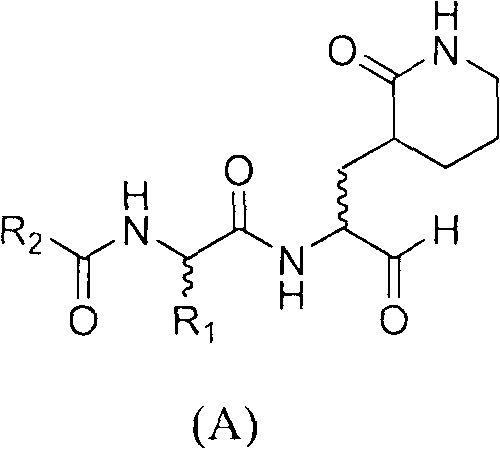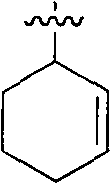Anti-enterovirus 71 (EV 71) caprolactam aldehyde compound and preparation method and purpose thereof
A technology of caprolactam aldehyde and EV71, which is applied in the field of formula compounds for the treatment of enterovirus 71 infection, can solve the problem that the virus transcription and replication cannot continue normally
- Summary
- Abstract
- Description
- Claims
- Application Information
AI Technical Summary
Problems solved by technology
Method used
Image
Examples
example
[0096] The present invention is illustrated in more detail by the following non-limiting examples, but the present invention is not limited to the following examples. Temperatures are provided in degrees Celsius in the following examples. Unless otherwise stated, solution percentages express a weight-to-volume relationship, and solution ratios express a volume-to-volume relationship. The structures of the compounds in the examples were determined by one or more of the following methods: nuclear magnetic resonance spectrometer, high-resolution mass spectrometry, and thin-layer chromatography. If the given structural formula representing the compound does not match its chemical name, the structural formula shall prevail.
[0097] NMR spectrum ( 1 H NMR and 13 C NMR) was measured with a Bruker 400 spectrometer at a field strength of 400 MHz. Chemical shifts are expressed in parts per million (ppm, δ) relative to the internal standard tetramethylsilane. 1 The multiplicity of ...
Embodiment 1
[0100] Example 1 Preparation of N-Boc-L-(+)-dimethyl glutamate (1-2)
[0101]
[0102] At 0°C, slowly add acetyl chloride (5 mL) dropwise into methanol (100 mL), stir for 5 minutes, then add glutamic acid (10 g, 67.9 mmol), continue stirring and heat to reflux, and keep the reflux temperature for 2 hours . The reaction was stopped, the solvent was removed under reduced pressure, and recrystallized from ether. The obtained oil was dissolved in THF (150mL), TEA (28.5mL, 203.7mmol) was added dropwise at 0°C, kept stirring at 0°C for 5 minutes, and dicarbonate dicarbonate dissolved in THF (30mL) was added dropwise. Tert-butyl ester (17.8 g, 81.5 mmol), stirred to room temperature for 2.5 hours. After the reaction, the solvent was distilled off under reduced pressure, water (200 mL) was added to the residue, extracted from the aqueous phase with DCM (2×200 mL), the combined organic phases were dried over anhydrous sodium sulfate, and then concentrated to obtain the crude produ...
Embodiment 2
[0103] Example 2 Preparation of 2-tert-butoxycarbonylamino-4-cyanoethyl-glutaric acid dimethyl ester (1-3)
[0104]
[0105] At -78°C, lithium bis(trimethylsilyl)amide (78.5mL 1.0)M THF solution, 78.5mmol) was slowly added dropwise to N-Boc-L-(+)-glutamic acid Dimethyl ester (1-2) (10 g, 36.4 mmol) in anhydrous THF (200 mL), and the resulting solution was stirred at this temperature for 30 minutes. Then, keeping the temperature constant, bromopropionitrile (3.4 mL) was slowly added dropwise, and the reaction mixture was stirred at -78° C. for 2 hours. After the reaction was complete, glacial acetic acid (5 mL) was added to quench the reaction, and stirred to room temperature. First remove the solvent under reduced pressure, then add water (200mL), extract the aqueous phase with DCM (2×200mL), and dry the combined organic phase with anhydrous sodium sulfate, then concentrate, and the obtained crude product is passed through a flash chromatography column (PE: EA=2:1) to o...
PUM
| Property | Measurement | Unit |
|---|---|---|
| Titer | aaaaa | aaaaa |
Abstract
Description
Claims
Application Information
 Login to View More
Login to View More - Generate Ideas
- Intellectual Property
- Life Sciences
- Materials
- Tech Scout
- Unparalleled Data Quality
- Higher Quality Content
- 60% Fewer Hallucinations
Browse by: Latest US Patents, China's latest patents, Technical Efficacy Thesaurus, Application Domain, Technology Topic, Popular Technical Reports.
© 2025 PatSnap. All rights reserved.Legal|Privacy policy|Modern Slavery Act Transparency Statement|Sitemap|About US| Contact US: help@patsnap.com



